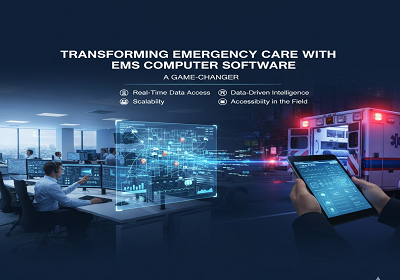
Technology increasingly shapes outcomes in emergency medical services, and investing in robust software is more critical than ever. Modern EMS operations rely on specialized computer systems designed for emergency care providers. These digital tools allow dispatchers, paramedics, and administrators to collaborate efficiently and respond rapidly. From managing patient records to optimizing ambulance routes, EMS computer software handles multiple operational tasks, ensuring faster, safer care for patients in critical situations.
What is EMS Computer Software?
EMS computer software refers to applications tailored specifically for emergency medical services. It includes electronic patient care reporting, billing, fleet tracking, and route optimization. Essentially, the software transforms traditional paper-based workflows into digital ecosystems, where data flows freely, decisions are accelerated, and operational outcomes improve reliably. With integrated systems, agencies can track every stage of patient care, from dispatch to hospital handoff, improving both efficiency and accountability.
Core Functionalities
- Electronic Patient Care Reporting (ePCR): The electronic patient care report system replaces manual forms, reducing errors and improving data accuracy. Paramedics record vital signs, administer treatments, and report patient outcomes in real time. Hospitals and EMS administrators gain immediate visibility into patient care, enabling better preparation for incoming patients. Furthermore, this digital approach supports compliance with healthcare regulations, ensuring accurate reporting and reducing liability risks.
- Billing Automation: Integrated billing modules automate invoicing, track payments, and monitor financial performance. Automation minimizes human error, reduces administrative burden, and accelerates revenue cycles. For many EMS agencies operating under tight budgets, this efficiency is essential for maintaining financial stability. Ultimately, billing automation allows staff to focus on patient care rather than paperwork, improving overall service delivery.
- Dispatching and Fleet Management: Advanced dispatch modules coordinate ambulances and crews with precision. Integrated GPS tracking and automated route optimization help ensure rapid responses to emergencies. Features such as call prioritization and real-time updates allow dispatchers to allocate resources efficiently and adjust dynamically to changing situations. In this way, EMS software transforms reactive operations into proactive, data-driven emergency responses.
Leveraging Data for Performance Improvement
Data analysis is critical for continuous improvement in EMS operations. By collecting metrics such as response times, patient outcomes, and service efficiency, agencies gain actionable insights. This information helps identify deployment bottlenecks, optimize staffing, and enhance training programs. Over time, these insights improve operational efficiency, strengthen patient care, and build organizational resilience. In essence, data collected through EMS software becomes a strategic tool for decision-making across all levels.
Key Features of Effective EMS Software
- Real-Time Data Access: All stakeholders, from paramedics to hospital staff, require immediate access to accurate, real-time data. EMS software must support instant updates to facilitate timely decisions.
- Scalability: The system should perform effectively for both small local services and large metropolitan networks, providing flexibility for agencies of any size.
- Data-Driven Intelligence: EMS software converts raw data into actionable intelligence, allowing organizations to improve operational decisions, resource allocation, and patient outcomes.
- Accessibility in the Field: Mobile access is essential, with software optimized for tablets, smartphones, and other devices. Staff must engage with the platform anywhere, anytime, without disruption.
Choosing the Right EMS Software
Organizations should evaluate potential EMS software based on user-friendly interfaces, seamless integration with hospital electronic health records, strong data security, and reliable vendor support. Additionally, EMS-specific experience matters more than general healthcare IT expertise. Selecting the right software partner is a strategic decision that directly impacts patient care quality and operational efficiency.
Training and Implementation
Even the most advanced platform fails without proper adoption. EMS leadership must invest in thorough training programs for paramedics, dispatchers, and administrators. Iterative feedback loops ensure that workflows are optimized, challenges are addressed, and users become proficient quickly. Effective implementation maximizes ROI, strengthens staff confidence, and ensures that digital tools enhance, rather than complicate, emergency care operations.
Conclusion: EMS Software as a Strategic Necessity
EMS computer software delivers significant benefits, including enhanced patient care, operational efficiency, financial management, and actionable insights. Moving from manual processes to integrated digital systems allows emergency services to operate smarter and respond faster. As demand for emergency care continues to grow, adopting capable EMS software becomes essential. By selecting software thoughtfully, training staff thoroughly, and leveraging data strategically, agencies can ensure they are ready for every emergency, improving outcomes for patients and communities alike.







